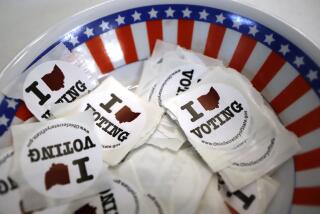Appeals court rules U.S. currency is discriminating against the blind
- Share via
WASHINGTON — The look and feel of America’s paper money may have to change, now that a U.S. appeals court here has ruled that blind and other visually impaired people are discriminated against by the nation’s currency.
Canada has put “embossed dots” on its bills that vary by denomination, while the Euro includes a foil feature that can be detected by touch, the judges said. The United States is nearly alone in the world in using bills that are the same in size and color in all denominations, they added.
“A paper currency designed for the sighted means that millions of visually impaired individuals are dependent on the kindness of others . . . in using U.S. currency,” Judge Judith Rogers said Tuesday in a 2-1 decision. This “denial of meaningful access to U.S. currency” for blind persons violates a 1973 law that prohibits the government from discriminating against people because of their disabilities, she concluded.
The court did not say what must be done to cure the problem. Treasury Secretary Henry M. Paulson, or more likely his successor, can “choose the means of bringing U.S. currency into compliance,” the judges said.
The Treasury Department said it was reviewing the ruling and had no comment. The government could ask the full appeals court to reconsider the matter, or it could appeal the issue to the Supreme Court. It has 90 days to decide its next step.
“This is an important victory for people who are blind and visually impaired,” said Mark Richert, director of public policy for the American Council of the Blind. “We . . . look forward to the day when people with vision loss have as reliable access to paper money as everyone else.”
His view is not shared by all advocates for the blind. Marc Maurer, president of the National Federation of the Blind, sharply criticized the rival group’s lawsuit as a “publicity stunt” last year.
It is “damaging to the blind not only because it focused attention on a putative problem that did not exist but also [because] it would present the capacity of the blind in a false and misleading manner,” said Maurer, who is blind. In his view, handling currency can be a “challenge, but it is largely a manageable one.”
About 3.7 million people in this country are visually impaired, according to a National Academy of Sciences study cited by the court, and 200,000 of those have no vision at all.
The Rehabilitation Act and its ban on government discrimination against the disabled had a major effect across the nation in the 1970s and ‘80s. It forced public buildings, libraries, schools and colleges to add ramps, walkways and elevators to accommodate people in wheelchairs and to add aural or visual signals to aid those who were blind or deaf.
Six years ago, the American Council of the Blind sued the Treasury Department on behalf of two men whose vision was badly impaired. They said that using money is “an essential ingredient of independent living,” yet “for millions of Americans with blindness or low vision, it is impossible to recognize the denomination of bank notes.”
They sought a court order that would require the government to accommodate their disability by changing the size, color and feel of paper currency above the $1 bill. They argued that this would not pose a great burden for the U.S. government, noting that most other nations had already made such changes.
A federal judge ruled in favor of the blind plaintiffs two years ago, but the Treasury Department appealed, arguing that the change would prove costly. About 7 million vending machines dispense food and beverages across the nation, and retooling or replacing them to take bills of different sizes would cost $3.5 billion, an industry group said.
Government lawyers also questioned whether embossed bills would last long enough to be worthwhile. And they said blind people can use credit cards or rely on sales clerks for help.
But the appeals court on Tuesday rejected the government’s claims as unconvincing.
--
More to Read
Sign up for Essential California
The most important California stories and recommendations in your inbox every morning.
You may occasionally receive promotional content from the Los Angeles Times.










